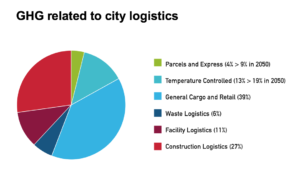Lots of attention has been given in recent years to the “massive” increase in delivery traffic in cities and residential districts. Web stores and the vans that deliver their parcels often get the blame for that. My neighbors wonder if it really can’t all just fit into one delivery van. They see PostNL, DHL, Albert Heijn, Coolblue and DPD all driving down the street, one after the other.
They also don’t understand why those delivery vans always seem to come when nobody’s at home. And it’s one of the biggest sources of irritation in the city: illegally parked vans. Is it time to sound the alarm about delivery vans?
Sustainable
Connekt, the Dutch public-private network for sustainable mobility, presented some hard data on the subject during the recent conference of the Dutch logistics sector. Almost a million delivery vans are currently driving around in the Netherlands. In Dutch cities, 80% of packages are delivered by such vans. Surprisingly though, only 2 to 3% of those delivery vans actually deliver parcels to homes and offices. Together, those vans make more than 300 million deliveries. Because they drive a bit more than average, those parcel-delivery vans account for just over 5% of all freight movements in Dutch cities.
And for the most part we are talking about relatively new and energy-efficient delivery vans. Those delivery vans are responsible for only 1 to 2% of the CO2 emissions resulting from road transport in the Netherlands. What is more, the parcel-delivery companies have for the use of cargo bikes and light electric vehicles. All in all, the situation is worthy of being called “sustainable”.
Growth
Experts are predicting that a doubling of the number of online sales will not lead to many more delivery vans. Likewise, studies done abroad have shown that the enormous growth in online consumer orders has hardly led to any more delivery vans. The parcel-delivery companies are simply organising things in a smarter way.
Even so, the number of delivery vans in cities is growing rapidly: by 3 to 5% each year. That growth is primarily due to deliveries made to construction sites, to hotels, restaurants and cafés, and to stores. Those are the places where experts are seeing more and more smaller deliveries being made, and with strict delivery times and an ever-increasing number of delivery vans to boot. That is not a sustainable situation.
Residential areas
So is there nothing to worry about after all? The major parcel-delivery companies are managing things quite well. The problem lies in the expanding category of home deliveries being made by companies with transport on own account. Their deliveries are an extension of their online experience. They prefer to take care of it themselves.
The growth, especially in connection with groceries ordered online, is going to lead to many more deliveries, particularly in residential areas. But that’s not what our streets were designed to accommodate. Where now there are 12 to 15 delivery vans on a daily basis, in ten years that will be 50 to 60, also in the weekends. That is hardly a pleasant prospect. It is going to lead to congestion, to unsafe situations and to poor air quality. The delivery van no longer matches the scale of the street.
Livability
Is it time to sound the alarm about delivery vans? Not yet, if it we are talking about deliveries made to consumers at home. Yes, if more and more web stores decide to use transport on own account.
As the large cities will be developing new residential districts en masse, it would be smart to start thinking about how we will deliver goods to those new districts. With which small electric vehicles will we be entering those residential areas? Could we better serve consumers by having common pick-up points? And, how can we put the consumer behind the wheel, so that the delivery person will never have to find no one at home.

